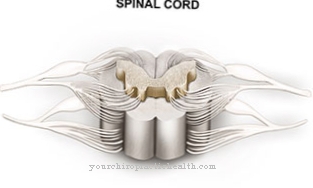Neurofibromatose is a collective term for hereditary diseases that have the development of neurofibromas in common. These are benign nerve tumors.
What is neurofibromatosis?

© peterschreiber.media - stock.adobe.com
Under the term Neurofibromatosis there are up to eight clinical pictures. However, only two are of central importance: neurofibromatosis type 1 (also known as “Recklinghausen's disease”) and neurofibromatosis type 2.
Since neurofibromatosis is caused by tumors of the nerves, it is characterized by a wide range of features: The symptoms are not limited to certain areas of the body, but can theoretically manifest themselves anywhere on and in the body. However, some symptoms are characteristic of neurofibromatosis. So-called milk coffee stains appear on the skin in both type 1 and type 2 neurofibromatosis.
Changes in the eyes are also common: nodules in the iris, so-called Lisch nodules, indicate tumors on the eye. Deficits in sensory perception, especially hearing, also define neurofibromatosis - the function of the nervous system can be partially impaired by tumor formation.
One of the decisive characteristics of neurofibromatosis type 1 is the occurrence of the "bell button phenomenon". In this case, the neurofibromas form a soft knot that can be pressed in with the finger as if there were a hole in it.
In neurofibromatosis type 2, the tumors can also often be seen and felt through the skin; In addition, skeletal changes can also occur here, for example severe deformations of the spine. As a result, orthopedic complaints usually arise.
causes
The cause of the Neurofibromatosis is due to a hereditary disease: A defect on chromosome 17 is responsible for neurofibromatosis type 1, and a gene on chromosome 22 for neurofibromatosis type 2. The disease is inherited as an autosomal dominant trait. One disease-bearing allele is therefore sufficient for the neurofibromatosis to be passed on.
The genetic defect leads to the formation of benign tumors that do not have metastases. The tumors are formed from Schwann's cells, which mainly surround the axons of the nerve cells and thereby electrically isolate them. Other tumors also develop from parts of the endo- and perineural connective tissue.
Tumor formation in the nervous system can impair its function, which explains numerous symptoms of neurofibromatosis. In the context of neurofibromatosis type 1, neurofibromas (nerve tumors) are formed, which affect the central as well as the peripheral and vegetative nervous system. In contrast to neurofibromatosis type 1, neurofibromatosis type 2 predominantly affects the central nervous system: tumors develop in the brain and / or spinal cord.
Symptoms, ailments & signs
Since there are two types of the disease, the symptoms also differ. Type 1 is characterized by benign, oval, light brown skin nodules (neurofibromas) that can often be seen immediately after birth. They form on the skin or along the nerves. At the beginning they appear only sporadically, in the further course they can cover the whole body. They are also known as café-au-lait (milk coffee stains) because of their color.
The nodules on the nerves can sometimes be seen through the skin with a bluish shimmer. If these nodules grow on the iris of the eye, they are called Lisch nodules. The skin manifestations can vary in size, some measuring just a few millimeters, others several centimeters. In addition, spots that look similar to freckles form in the armpits and in the groin region.
Other symptoms such as scoliosis, epileptic seizures or tumors on the optic nerve are possible. Type 2 neurofibromatosis rarely shows skin signs. Tumors of the auditory nerve are more typical; they are called acoustic neuromas or schwannomas and usually only develop after puberty.
They affect hearing and balance and can trigger tinnitus. However, tumors can also form on other nerves in the central nervous system. Another possible symptom of type 2 disease is clouding of the lens of the eye.
Diagnosis & course
For diagnosing the Neurofibromatosis There are slightly different core symptoms for types 1 and 2: Neurofibromatosis type 1 is diagnosed if, in addition to other criteria, at least five milk coffee stains and tumors in the skin (cutaneous) can be detected.
A diagnosis of neurofibromatosis type 2 is made when benign tumors are found on both auditory nerves. The course of the disease progresses slowly: Due to the relatively slow development of tumors, neurofibromatosis does not occur suddenly, but develops slowly. The severity of the course of the disease can vary greatly and is different from case to case. Neurofibromatosis is mild in around 60% of patients.
Complications that can occur as a result of the symptoms of the disease represent an additional health risk: Examples of possible complications are scoliosis and the associated pain or epilepsy. They require appropriate treatment and must also be monitored.
Complications
As a hereditary disease, neurofibromatosis is often quite mild, but it can also have very serious effects. For this reason, medical check-ups should be carried out on the child in order to identify possible complications quickly. Spinal curvature (scoliosis), brain tumors or tumors of the optic nerve are observed as complications. If the growths are under the skin (neurofibromas), severe pain and neurological disorders may occur.
Type I neurofibromatosis can also lead to epileptic seizures. Furthermore, partial performance disorders are also possible in children. These relate to learning difficulties in children with normal intelligence. Detecting possible complications in good time can help avoid problems later. No statement can be made about the further development of neurofibromatosis because it develops differently in each person.
In addition to mild courses, very difficult and complicated courses are also possible. While some of those affected by neurofibromatosis type I often develop only a few pigment spots at the beginning, others can be affected by tumors as early as infancy. In type II neurofibromatosis, the further course is also difficult to predict. In general, however, the number of tumors increases over the course of life. Overall, with both forms of the disease, the risk of developing malignant tumors increases as the disease progresses.
When should you go to the doctor?
If skin changes or abnormalities are observed in the newborn immediately after birth, they should be clarified by the doctors and members of the obstetrician team. Lumps on the skin, pigment formation, or discoloration must be examined. In particular, serious or life-threatening diseases are to be excluded in various tests. If the existing peculiarities of the skin's appearance increase in the weeks and months after the birth, a check-up visit with a doctor should take place.
Spots on the skin that spread to all areas of the body are considered unusual and should be presented to a doctor. The skin changes are similar to the known and harmless freckles, but can still be clearly differentiated and delimited from them. Swelling, pain or unusual behavior in the offspring are signs of a health problem that must be examined and treated by a doctor. If the person concerned suffers from impaired sensory perception, impaired vision or from epileptic seizures in the further growth and development process, there is cause for concern.
A reduction in hearing ability can be regarded as a warning signal. If the irregularities appear or if they increase in intensity, a doctor must be consulted immediately. In the event of changes in the skeletal system, palpable lumps under the skin or a deformation of the spine, a doctor's visit is required as soon as possible.
Treatment & Therapy
Since the Neurofibromatosis If the disease is suicidal, its treatment is limited to the surgical removal of the tumors and the treatment of sequelae of the disease. In particular, the tumors of the auditory nerves can be removed at an early stage with some success. In addition, there is no effective therapy option.
Outlook & forecast
Neurofibromatosis is an incurable disease. Scientists were able to determine the cause of a genetic defect. Since human genetics may not be changed according to the current legal requirements, treatment approaches focus on alleviating the patient's individually pronounced symptoms.
Treatment is advisable because the disease is associated with tissue growths and seizures.Alternative healing methods or the self-healing powers of the organism are therefore not sufficient to achieve long-term health improvement. In addition, the general risk of accidents is increased for some patients with balance disorders or existing hearing or vision impairments. You should be given the best possible support in everyday life in order to avoid secondary illnesses or unwanted complications.
The best results are achieved with an early diagnosis and an immediate start of treatment. Depending on the symptoms that have arisen, individual therapy methods are used to significantly improve the quality of life of the person affected. Dealing with the disease is learned so that states of emotional stress are kept as low as possible.
Regular visits to a doctor are required over the entire lifespan. In addition, the patient has to undergo repeated surgical interventions so that the tumors can be removed. Otherwise they can damage the surrounding tissue or lead to functional disorders of the organism and thus trigger a further deterioration in health.
prevention
A prevention of Neurofibromatosis is also not possible. However, early detection is crucial in order to avoid more severe manifestations or to alleviate the symptoms.
Aftercare
In most cases, those affected have very few options for direct follow-up care. For this reason, the person affected should consult a doctor as early as possible to prevent further complications or complaints from occurring.
The disease cannot be completely cured because it is a genetic disease. If those affected want to have children, it may be advisable to have a genetic examination and advice carried out in order to prevent neurofibromatosis from recurring. Most of those affected are dependent on the intake of different drugs.
First and foremost, regular intake and the right dosage have a positive effect on the further course. Not infrequently, the psychological support of those affected by one's own family is also very important, whereby especially loving and intensive discussions can have a positive effect on the further course.
Physiotherapy measures are also very important. Those affected can repeat many of the exercises at home. Neurofibromatosis does not usually reduce the life expectancy of those affected.
You can do that yourself
If neurofibromatosis is diagnosed, the most important action taken is close monitoring of symptoms. The doctor responsible will initiate further treatment steps so that the tumors can be removed quickly.
After an operation, the affected person has to take it easy. It is important not to expose the skin to any further stress, for example from aggressive shampoos or irritating clothing. Strict personal hygiene must also be observed in everyday life. Parents of affected children should ensure that bed linen is washed regularly and that the floors and surfaces in the home are cleaned as daily as possible. Further measures are limited to bringing the child to regular medical check-ups. This allows the course of the disease to be monitored and the necessary measures to be taken in the event of any complications.
Since neurofibromatosis often takes a severe course, you should also consult a therapist. The professional can support parents by showing ways to cope with stress. He can also establish contact with a self-help group. Affected parents are heard there and learn from other relatives how they can deal with the child's illness.


.jpg)


.jpg)





















